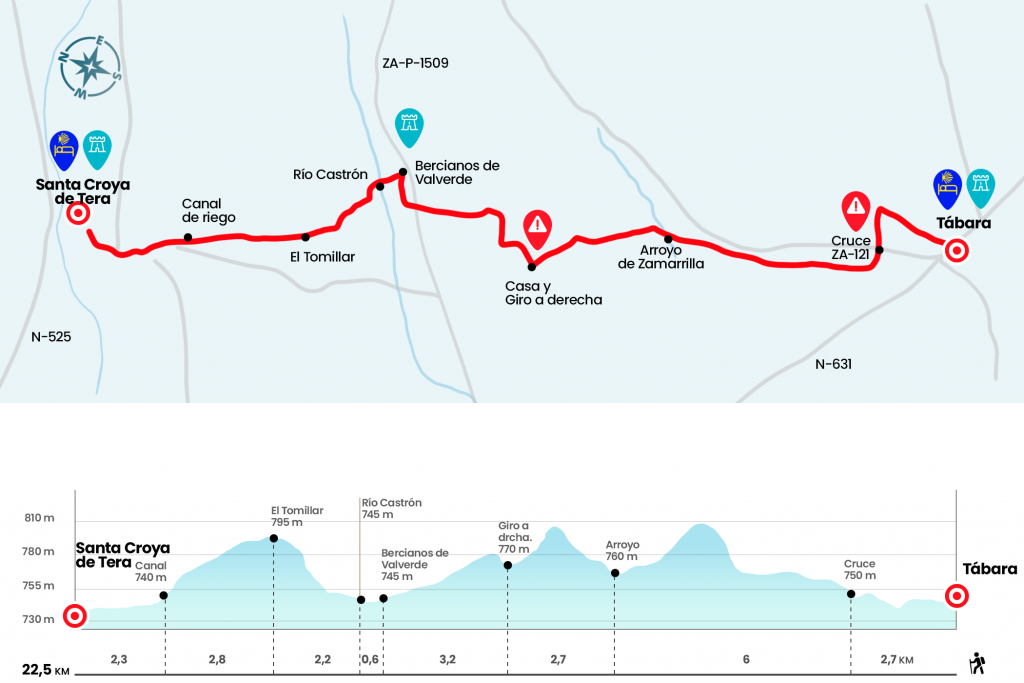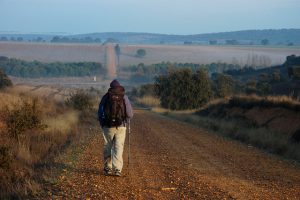Article translated by an automatic translation system. Press here for further information.
Era from Tábara to Santa Croya de Tera
Labyrinth of crosses leading to the gates of the Tera River Valley
Information about the stage 2: Era from Tábara to Santa Croya de Tera

Enlarge map
Points of interest in the stage 2: Era from Tábara to Santa Croya de Tera
The route
- Km 0. Tabara(All services)
From the hostel in Tábara there are two alternatives to start the stage. The easiest one is to follow the arrows that lead us to take the ZA-121 towards Pueblica de Valverde. In this way, after the kilometric point one, we leave the asphalt on the left to take a path. Those who choose the longest alternative must go down to the church of Santa Maria and take in front of the track that moves towards the AVE track so as not to cross it, go parallel to it a short section and turn left to the ZA-121, which will cross to join the other path (Km 2,7).
We walk from the front for about 400 meters to bend to the right and continue on the track until crossing a platform the AVE line, once crossed we continue straight several kilometers between oak and clear forests through several streams (Km 11,4).
At this point is the bifurcation perfectly signalized to continue along the traditional Camino which is directed to Bercianos, or to go to Villanueva de las Peras (see description of the route in the comments section), which has hostel, bar and ultramarines. The traditional route, after another change of direction, leads us to cross a local road, after which we arrived at Bercianos de Valverde. We pass by the church of San Pelayo (it is possible to access the tower, which provides great views) and we access the core by Calle Mayor.
- Km 14.6. Bercianos de Valverde(Social Bar on the top floor of the City Hall)
We say goodbye to Bercians turning left by Las Eras street and in 300 meters we cross the river Castrón, influent of the Tera (Km 15,2). In a couple of minutes turn left and in another, at the height of a chopera, to the right (Km 15,7). From the front we can see the first winery of the day, excavated and molded in the clay soil. Some more turns lead us to undertake a retreat next to more wineries, after which we will reach the site El Tomillar (Km 17.4). We follow a good section by piste, surrounded by a dense forest of thyme, jara and holm oaks, which is aborted in a irrigation canal (Km 20,2). After him we went to the ZA-120, through which we entered Santa Croya de Tera.
- Km 22,5. Santa Croya de Tera (Bar. Shops. Pharmacy)
From the closure of the private hostel of Santa Croya you have to go to the next village, Santa Marta de Tera, to make night in your hostel of pilgrims, the village is practically attached to Santa Croya. As soon as we leave Santa Croya we cross the bridge over the Tera, a river that forms Lake Sanabria and donates its flow to the Esla. We enter Santa Marta de Tera, whose 11th century Romanesque church is the jewel of the Sanabrés Road. We speak of the oldest known size of a pilgrim Santiago and it is located in one of the rinses of the southern front. The Apostle, with a staff and a staff, stretches the palm of his hand and overtakes his beauty and mystery. The visit is obligatory.
The difficulties
Remarks
In images
What to see, what to do
The hostels

¿Do you want to send any photo of "The Camino de Santiago"?
If you have any photos of "El Camino de Santiago" that you want to share with us, you can send them to us and enlarge the photo gallery


Forum: What pilgrims think about the Camino de Santiago
See all